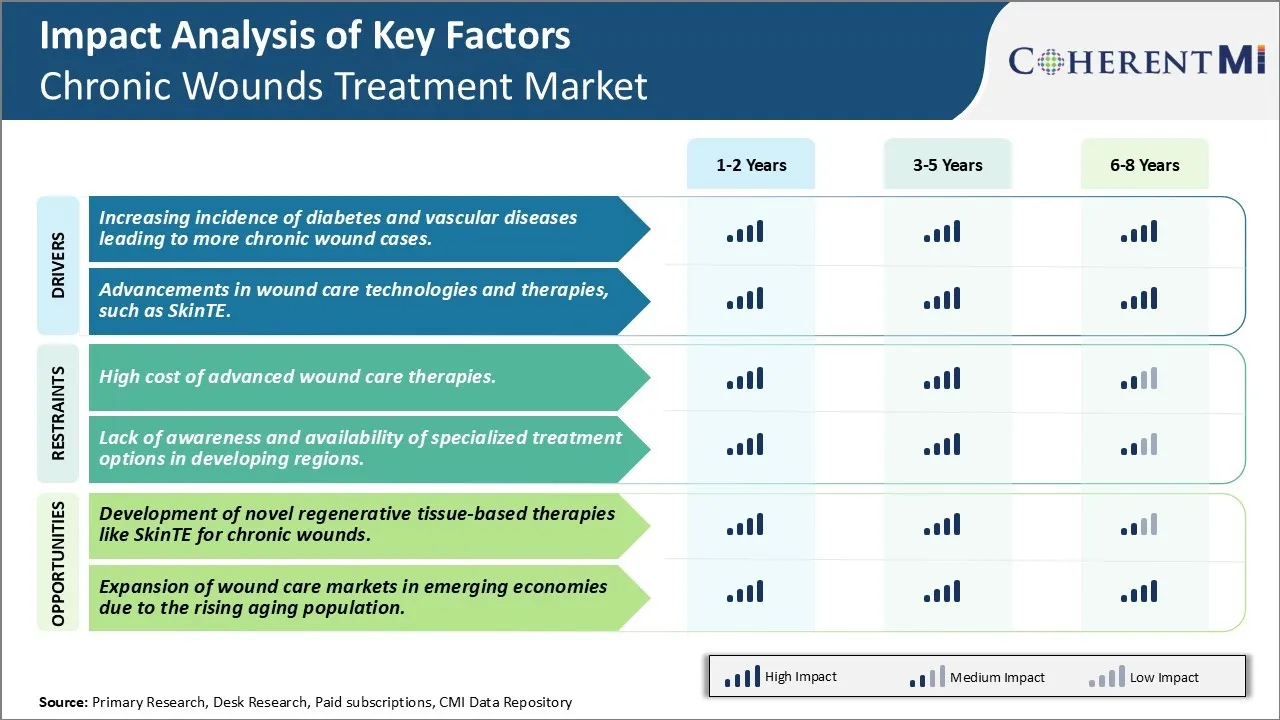Chronic Wounds Treatment Market Trends
Market Driver - Increasing incidence of diabetes and vascular diseases leading to more chronic wound cases.
As per the available medical studies and research, it has been witnessed that there is a significant rise in the number of people suffering from diabetes and vascular diseases globally. Diabetes is one of the leading causes of chronic wounds as high blood sugar levels in diabetes can damage nerves and reduce blood flow - both of which put people at higher risk of slow-healing wounds. Poorly controlled diabetes over long period can also lead to peripheral artery disease, or PAD which is narrowing of arteries supplying blood to the body's extremities. This obstruction in blood vessels reduces blood flow and oxygen to the tissues, ultimately delaying natural wound healing process.
According to World Health Organization's recent report, the prevalence of diabetes among adults over 18 years of age has risen from 6.7% in 2000 to 10.5% in 2020. It is projected that around 642 million people or one in 10 adults will have diabetes by 2040. Most of the increase will occur in developing countries and emerging nations where lifestyle is changing rapidly leading to more obesity and lesser physical activities. Similar trends have been seen for vascular conditions as well according to various epidemiological studies. This substantial growing patient pool of diabetes and vascular diseases will significantly drive the demand for advanced chronic wound care management options as healing of wounds formed in these patients require much more time and intervention. Treatment expenditures per case also increases manifold for chronic wounds. All these factors directly translate to continuous increase in chronic wounds treatment market worldwide to handle this growing patient caseload across various healthcare settings.
Market Driver- Advancements in Wound Care Technologies and Therapies, such as SkinTE
The chronic wounds treatment landscape has transformed considerably over past few years with progressive innovations focusing on faster healing through tissue regeneration approach. Introduction of novel wound dressings, devices, skin and nerve substitutes has provided clinicians and patients with much improved options compared to traditional treatment modifications. Continuous research is also bringing more refined solutions to address various wound etiologies more effectively.
A prime example is SkinTE, a first-of-its-kind bioengineered skin substitute made from a patient's own cells. This latest advancement uses an innovative manufacturing process involving gentle harvesting of skin cells non-invasively through a small skin biopsy. The cells are then multiplied in the laboratory to create an intact and living sheet mimicking natural skin structure and function. During application, SkinTE helps regenerate all layers of the skin by promoting tissue growth, blood vessel formation and re-epithelialization. Successful clinical outcomes have been shown even for recalcitrant chronic wounds that failed to respond to standard care over long durations. The chances of infection, pain and need for dressing changes are also lower compared to alternative available grafts or flaps.

Market Challenge - High Cost of Advanced Wound Care Therapies Limits the Market Growth.
One of the major challenges faced by the chronic wounds treatment market is the high cost of advanced wound care therapies. Chronic wounds such as diabetic foot ulcers, pressure ulcers, and venous leg ulcers often require expensive treatment options such as skin substitutes, growth factors, and topical antibiotics to heal. These advanced therapy products generally cost between USD 500 to USD 3000 per application with most patients requiring multiple applications. This steep financial burden makes such cutting-edge treatments inaccessible to a large portion of patients, especially those in the developing world. The soaring costs have also put immense pressure on the healthcare systems and medical reimbursements cover only a part of the total expenses in many countries. Additionally, long and recurrent hospitalization further increases the economic burden on patients as well as payers. This prohibitively high cost of care poses a significant barrier to the widespread adoption of evidence-based regenerative therapies for chronic wounds.
Market Opportunity: Development of Novel Regenerative Tissue-Based Therapies like SkinTE for Chronic Wounds
One major opportunity for the chronic wounds treatment market lies in the development of novel regenerative tissue-based therapies. SkinTE by PolarityTE is a promising tissue-based regenerative therapy currently being investigated for chronic wound applications. It uses a patient's own skin cells to grow new tissue in the wound, mimicking the body's natural wound healing process. This engineered skin graft aims to overcome key limitations of existing products by potentially providing a permanent solution with a single application. Preliminary clinical data has demonstrated SkinTE’s ability to facilitate wound closure and regeneration of natural skin tissue in chronic wound patients. With its off-the-shelf availability and relatively low cost of around USD 3000 per application, SkinTE has the potential to significantly increase access to advanced care, especially in developing countries. Its tissue regenerative approach could also minimize need for repeat treatments and long hospital stays. This novel regenerative technology holds immense potential to transform chronic wound management if proven effective and economical through further clinical research.